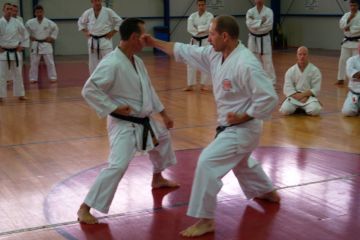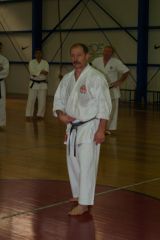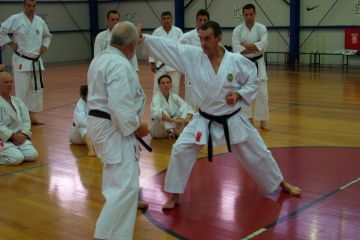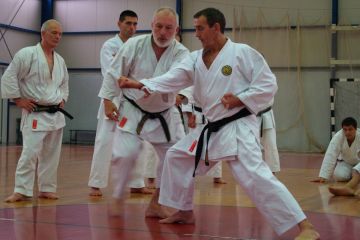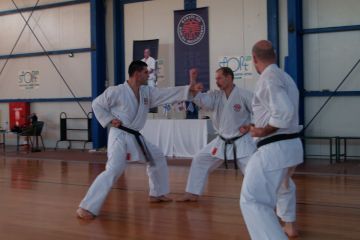KSKA - Aki Gasshuku at Loutraki / Greece 15.-18.10.2009
By Oliver Sprinz, Germany
The KSKA Aki-Gasshuku in Loutraki / Greece started this time already at Thursday evening. The Aki-Gasshuku was led by the Shihans Dirk Heene, Jim Martin, Velibor Dimitrijevic, and Mike Fedyk.

The Acropolis |
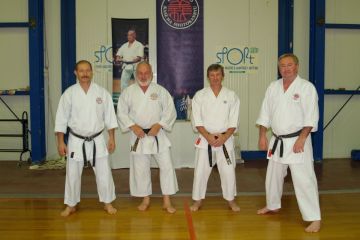
Members of the KSKA Shihankai |
The Aki-Gasshuku was organised by Sensei Velibor Dimitrijevic. Thanks again for the excellent organisation. About 40 Karatekas from Sweden, Finland, UK, Scotland, Belgium, Germany, Greece, and Serbia attended this seminar.
The host Sensei Velibor hold the first session on Thursday evening. At the first part of his training sensei Velibor explained and showed 4 different ways of respiration technique:
- inhale slowly - exhale slowly
- inhale slowly - exhale fast
- inhale fast - exhale slowly
- inhale fast - exhale fast
Sensei Velibor explained, that through the practice of different respiration techniques a more conscious respiration will evolve. Sensei Kase practiced this kind of respiration many times.
The respiration techniques were then combined with kihon exercises which comprised of blocking and counter attack with tai-sabaki gyaku-uraken combinations. The emphasis was to change after the block the direction of the of the attacker. The kihon combination were then applied in kumite with partner, were sensei Velibor put an emphasis on the correct timing for the block and counter attacks.
Rooting, body position and breathing are important for a successful attack and block as well. And, sensei Velibor said: Tanden-power is necessary to have maximum energy development.
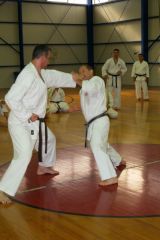
If body position, timing and respiration is not good, |
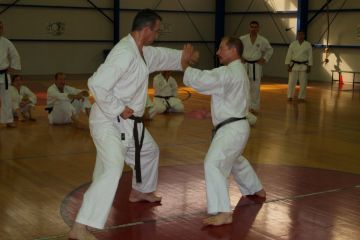
If the timing, body position, rooting and respiration is correct |
The second training at 5 p.m. was held by Sensei Jim Martin. The emphasis of his training was the kata Sochin, but with open hand techniques. This variation was quite demanding for karate which were not so familiar with the kata Sochin, where you suddenly have to use shuto and haito instead of gedan barai and and tsuki.
We had always enough time to practice this new form of Sochin. Furthermore we had top practice for every sequence the bunkai of the open hand techniques, which made it more clear of how to apply the new learned form. The attack and blocking combinations were very demanding for the attacker and the defender, since there were a lot of tai sabaki movements included as well.
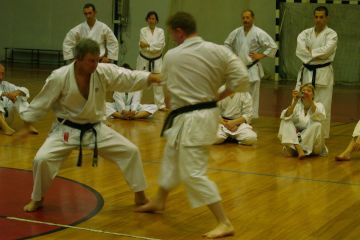
Sensei Jim Martin shows how to prepare for a gyaku haito |
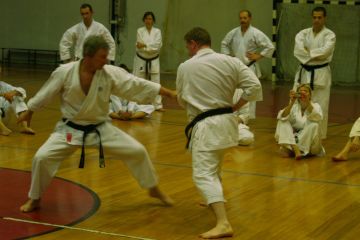
by controlling the fore arm of the opponent |
On the second day sensei Mike Fedyk took the first session. His emphasis was Ten-No-Kata first as kihon and then with partner. First we had to concentrate only on our blocking skill with a strong emphasis on timing (Sensei Mike hit in the same notch as sensei Velibor), and afterwards on blocking with setei counter technique. Sensei Mike also mentioned, that the attacker always has to keep up the pressure during the attack.

Sensei Mike Fedyk with a finish Karateka in gedan kamae for uchi ude uke |
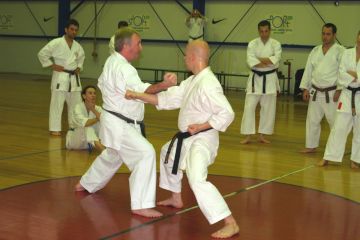
Sensei Mike Fedyk with uchi ude uke |
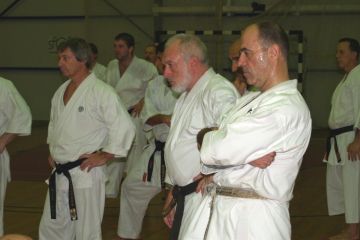
Senseis Jim Martin, Dirk Heene and former KSKA secretary Spiros Drousolakis |
The afternoon training was held by sensei Dirk Heene. He started the training with some energy aspects of qi-gong, to develop internal ki. Sensei Dirk demonstrated also the interconnection of qi-gong to our Shotokan katas, which incorporate a lot of this energetic exercises.
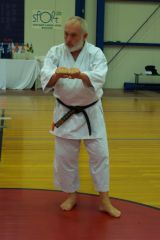
Sensei Dirk Heene explains |
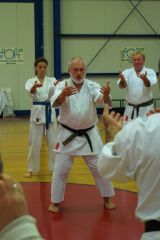
Sensei Dirk with some energy exercises |
With the qi-gong exercises sensei Dirk Heene wanted us to collect energy for the second session. The second session with sensei Dirk was about kake waza, block and afterwards guiding the attacking fist into another direction, unbalancing the attacking opponent. In this case the counter attack is easier and safer. It is also possible to change the direction after the block with tai sabaki gyaku uraken.
The last training on Sunday was again held by the chief intructor of KSK Greece, Sensei Velibor Dimitrijevic. Sensei Vebo started with some kihon combinations, which we practiced with variations. It was not only physically, but also mentally demanding.
In the second part of the training the emphasis was on kumite against 2 opponents. Sensei Vebo explained the importance of the right tactics using tai sabaki, not moving into the wrong direction (towards the second opponent). These exercises were again very demanding and needed a lot of concentration.
Conclusion:
This was again an excellent KSKA Gasshuku in a very pleasant surrounding which were only embittered through a heavy rain shower in Loutraki. The atmosphere among the participants was brilliant and between the training sessions we had a lot of opportunities to communicate with each other.
Oliver Sprinz, Germany


